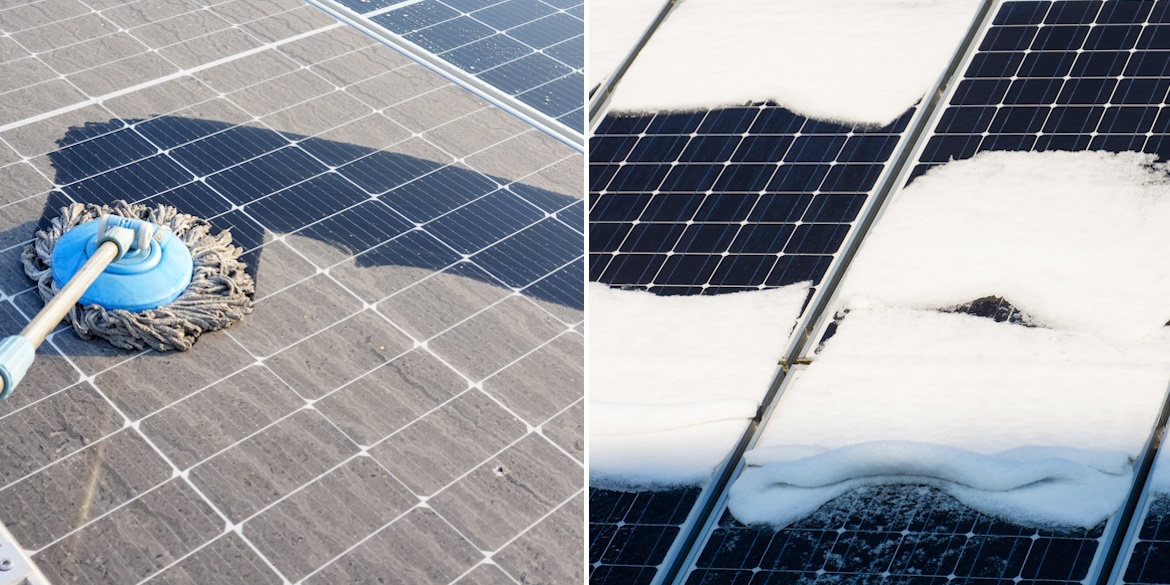Soiling and snow on PV systems can lead to significant annual energy losses, reaching up to 50%1 and 40%2 in certain regions. Our study investigates common models for estimating soiling and snow-related energy impacts. By analyzing these soiling and snow loss models at a 1 km spatial resolution, incorporating typical PV system parameters and leveraging SolarAnywhere V3.7 datasets, we aim to highlight model variation and the importance of accurate inputs to minimize PV performance uncertainty.
Understanding Soiling Model Variations
The Humboldt State University (HSU) and Kimber soiling loss models are the prevailing soiling loss models in the industry. While the HSU model relies on particulate matter (PM2.5, PM10) and rain accumulation as core input parameters,3 the Kimber model relies on user-applied assumed soiling loss rates and system cleaning frequency.4 To simply compare the two, the HSU model is more dependent on observed weather data, while the Kimber model is more dependent on empirical data and industry practice.
In the high-soiling location of Harad, Saudi Arabia, the HSU model predicts an annual energy loss of 31.0% while the Kimber model estimates 21.6%. Monthly energy losses from soiling ranged from 14.0% to 34.4% when compared to a perfectly clean system. While both models have the same order of magnitude for loss estimation, they vary significantly in absolute power impact.
Figure 1: Comparison of HSU and Kimber Soiling Loss Models
Understanding Snow Model Variations
We analyzed two snow models for this report: NREL and Townsend. The NREL model uses a history of daily accumulated snow depth and temperature in its calculation and considers snow sliding as the dominant process of snow removal, neglecting snow melting and wind effects.2 The Townsend model, on the other hand, includes monthly accumulated snow depth with additional ambient condition inputs like temperature, humidity, wind speed/direction and snow moisture content.5
In the snowy location of Aurora, Minnesota, the NREL model predicts an annual energy loss of 17.3% while the Townsend model estimates a lower value of 3.1%. In this study the results between models differ remarkably. For example, the difference in snow-loss impact between models was 71.7% in the month of January. Ensuring appropriate modeling parameters is crucial for minimizing uncertainty and has significant impact on results. Improper implementation of the model and tuning per site may lower their practical effectiveness.
Figure 3: Comparison of NREL and Townsend Snow Loss Models
In the figure below, we depict the NREL model’s projected maximum monthly snow loss over the United States.
Figure 4: Maximum Percent Monthly Snow Loss (%)
Strategies for characterizing uncertainty of PV project soiling and snow loss
The estimated soiling and snow-losses exhibit considerable variability, dependent upon location, model selection, and input parameters. However, one fact remains evident: unmitigated soiling and snow can pose significant impacts to PV performance.
Clean Power Research® cannot endorse one model over another in terms of accuracy, as estimated impacts of soiling and snow using these models can vary significantly based on location and input parameters. However, by employing various models for soiling and snow loss, coupled with accurate model inputs and reliable irradiance data from SolarAnywhere, industry experts can establish effective strategies to minimize performance uncertainty when modeling PV systems in complex climate conditions.
Click the link below to learn more about SolarAnywhere energy modeling services.
References
1 Hicks, W. (2021, April 1). Scientists Studying Solar Try Solving a Dusty Problem. National Renewable Energy Laboratory (NREL). Link
2 Keith, J., & Ryberg, D. (2017). Integration, Validation, and Application of a PV Snow Coverage Model in SAM. National Renewable Energy Laboratory. Technical Report No. NREL/TP-6A20-68705. Link
3 Coello, M., & Boyle,L. (2019, June 12) Simple Model For Predicting Time Series Soiling of Photovoltaic Panels. IEEE Journal of Photovoltaics. DOI: 10.1109/JPHOTOV.2019.2919628. Link
4 Kimber A, Mitchell L, Nogradi S, Wenger H. (2006). The Effect of Soiling on Large Grid-Connected Photovoltaic Systems in California and the Southwest Region of the United States. IEEE 4th World Conference on Photovoltaic Energy Conference. DOI: 10.1109/WCPEC.2006.279690. Link
5 Townsend, T., & Powers, L. (2011). Photovoltaics and snow: An update from two winters of measurements in the SIERRA. 2011 37th IEEE Photovoltaic Specialists Conference (pp. 1-4). IEEE. DOI: 10.1109/PVSC.2011.6186627. Link
